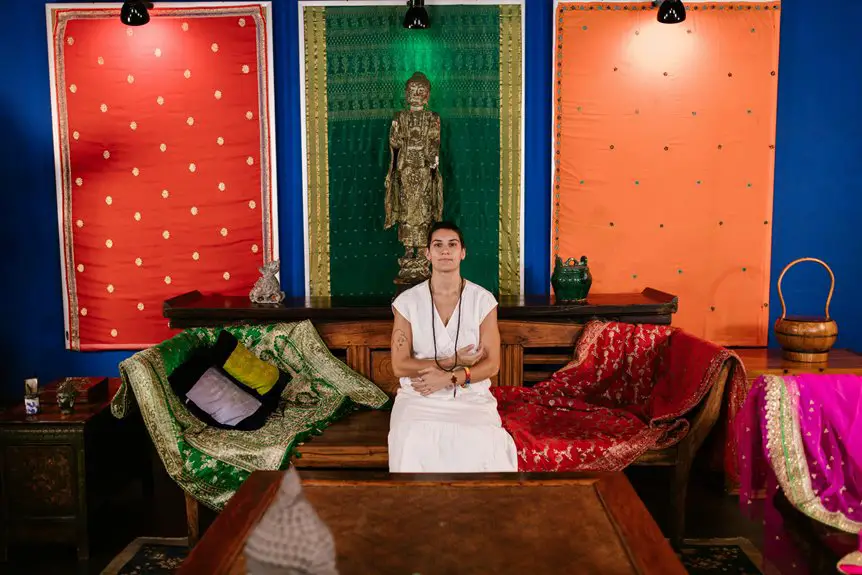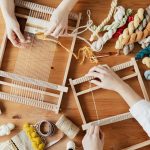You’ll find Lee Jofa Ikat fabrics blend ancient ikat techniques with modern designs, creating vibrant, softly blurred patterns full of history and artistry. This textile tradition started thousands of years ago, involving a resist-dye process that forms ikat’s signature look. Lee Jofa updates these timeless motifs with quality craftsmanship and contemporary appeal, making them perfect for stylish interiors. Keep exploring to discover how these fabrics can enrich your space and how to care for them properly.
Table of Contents
Key Takeaways
- Ikat textiles originate from ancient resist-dyeing traditions across Asia, Central America, and Africa with rich cultural storytelling.
- Lee Jofa popularized ikat by adapting traditional patterns into contemporary, elegant designs for modern interiors.
- Ikat patterns feature blurred edges, soft watercolor effects, and rhythmic geometric or abstract motifs.
- Lee Jofa combines traditional hand-tying dye techniques with advanced machinery to ensure pattern precision and vibrant colors.
- Proper care involves gentle cleaning, avoiding harsh chemicals, and storing textiles away from sunlight to maintain vibrancy.
The Origins and Evolution of Ikat Textiles
Although ikat textiles have ancient roots, their vibrant patterns and unique dyeing techniques continue to captivate designers and collectors today.
Ikat’s timeless patterns and dyeing artistry continue to inspire and enchant modern creators and enthusiasts alike.
When you explore ikat’s origins, you’ll find it dates back thousands of years across Asia, Central America, and parts of Africa. The method involves resist-dyeing the threads before weaving, creating designs that seem to float on the fabric.
As you trace its evolution, you’ll notice how different cultures adapted ikat to their traditions, materials, and artistic styles. Over time, ikat spread through trade routes, influencing textile traditions widely.
Today, you can appreciate how this ancient craft blends history with innovation, making ikat fabrics not just beautiful but also rich with cultural significance and storytelling.
Key Characteristics of Ikat Fabric Patterns
As you explore ikat fabrics, you’ll notice their patterns stand out for more than just color.
Ikat designs feature distinctive blurred edges, a hallmark created by the resist-dyeing process on yarns before weaving. This technique gives each pattern a soft, almost watercolor effect that’s hard to replicate with printed fabrics.
You’ll also see symmetrical motifs, often geometric or abstract, repeating rhythmically across the fabric. The interplay of dyed and undyed areas produces a dynamic, layered look that changes with light and angle.
Plus, the texture tends to be rich and tactile, reflecting the careful craftsmanship behind each piece.
These characteristics make ikat fabrics uniquely vibrant and visually enchanting, inviting you to appreciate the artistry woven into every yard.
Lee Jofa’s Role in Popularizing Ikat Designs
Discover how Lee Jofa transformed ikat fabrics from traditional textiles into coveted design elements in modern interiors.
When you choose Lee Jofa’s ikat designs, you tap into a rich heritage that’s been carefully adapted for contemporary tastes. The brand skillfully blends classic ikat patterns with fresh color palettes, making these fabrics versatile for any space.
You’ll notice their collections often balance bold motifs with subtle elegance, appealing to designers and homeowners alike. By consistently introducing ikat into their lines, Lee Jofa has elevated the fabric’s status beyond ethnic craft to a mainstream design staple.
If you want to infuse your interiors with a global yet sophisticated vibe, Lee Jofa’s ikat fabrics offer timeless style that’s both authentic and accessible.
Techniques Used in Creating Lee Jofa Ikat Fabrics
Lee Jofa crafts their ikat fabrics using a meticulous dyeing and weaving process that brings each pattern to life with striking clarity.
You’ll notice that the process starts with carefully tying sections of yarn to resist dye penetration, creating precise patterns when the fabric is woven. This resist-dyeing technique requires skill and patience, as multiple dye baths are often needed to achieve the characteristic vibrant colors and intricate designs.
After dyeing, the yarns are aligned on the loom to guarantee the patterns match perfectly once woven.
Lee Jofa’s artisans use both traditional hand-tying and advanced machinery to maintain consistency and quality.
When you handle their ikat fabrics, you’re experiencing the harmony of craftsmanship and innovation in every thread.
Styling Tips for Incorporating Ikat Fabrics in Interiors
The careful craftsmanship behind Lee Jofa’s ikat fabrics makes them a standout choice for adding texture and color to your space.
To style these vibrant patterns effectively, consider these tips:
- Use ikat as accent pillows or throws to introduce pattern without overwhelming the room.
- Pair ikat upholstery with neutral walls and furniture to balance boldness with calm.
- Mix ikat fabrics with solid colors that pick up hues from the pattern for cohesive layering.
- Incorporate ikat curtains or drapes to create a focal point and add visual interest.
Caring for and Maintaining Lee Jofa Ikat Textiles
You’ll want to handle Lee Jofa Ikat fabrics with care to keep their vibrant patterns intact.
Use gentle cleaning methods and avoid harsh chemicals that could damage the fibers.
When storing, keep them in a cool, dry place away from direct sunlight to prevent fading and deterioration.
Cleaning Techniques
Although delicate, Lee Jofa Ikat textiles can stay vibrant and beautiful when you follow proper cleaning techniques. Treat these fabrics gently to preserve their intricate patterns and colors. Here’s how to clean them effectively:
- Always check the care label before cleaning to avoid damage.
- Use mild detergent and cold water for hand washing; avoid harsh chemicals.
- Gently blot stains with a clean cloth instead of rubbing to prevent fabric distortion.
- Air dry your Ikat textiles flat, away from direct sunlight, to maintain color integrity.
Avoid machine washing or tumble drying as these can weaken fibers and fade dyes.
Storage Recommendations
Proper storage plays an essential role in preserving the beauty and longevity of your Lee Jofa Ikat textiles.
Always store them in a cool, dry place away from direct sunlight to prevent fading and fabric deterioration. Use breathable cotton bags or acid-free tissue paper to wrap your fabrics, avoiding plastic covers that trap moisture and encourage mold.
Lay textiles flat whenever possible to maintain their shape and prevent creases. If you must fold them, pad folds with tissue paper to minimize stress on the fibers.
Keep your storage area clean and check your fabrics periodically for signs of damage or pests.
Frequently Asked Questions
Where Can I Buy Authentic Lee Jofa Ikat Fabrics?
You can buy authentic Lee Jofa Ikat fabrics directly from authorized dealers, high-end fabric stores, or online retailers specializing in luxury textiles. Check Lee Jofa’s official website for dealer locations and trusted sellers to guarantee authenticity.
Are Lee Jofa Ikat Fabrics Eco-Friendly?
Sustainable sourcing sparks serious scrutiny. While Lee Jofa Ikat fabrics boast beautiful, bold designs, you’ll want to check specific collections for eco-friendly elements since not all fabrics fully focus on environmentally conscious crafting methods.
How Do Lee Jofa Ikat Fabrics Compare in Price to Other Brands?
You’ll find Lee Jofa Ikat fabrics generally priced higher than many other brands due to their quality and craftsmanship. While they aren’t the cheapest, you’re paying for unique designs and durable materials that often justify the cost.
Can Lee Jofa Ikat Fabrics Be Used for Outdoor Furniture?
Lee Jofa Ikat fabrics aren’t typically designed for outdoor use since they lack weather-resistant treatments. If you want durability outdoors, you’ll need fabrics specifically made to withstand sun, moisture, and mildew for lasting furniture protection.
Do Lee Jofa Ikat Patterns Change Seasonally or Annually?
Wondering if Lee Jofa Ikat patterns change seasonally or annually? They don’t shift often, but designers occasionally introduce new variations. So, you can count on timeless Ikat styles with fresh updates now and then.
- What Are Gore-Tex Boots and Why Are They Popular? - July 2, 2025
- Where Can I Buy the Best Gore-Tex Hiking Boots? - July 2, 2025
- Does Gore-Tex Really Work as Advertised? A Review - July 2, 2025







